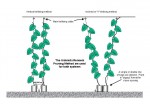Pruning peppers for optimum yields in hydroponics
Pruning peppers will have a significant effect on yields over the production life of the crop. The correct pruning method will also increase ventilation and thereby decrease disease and pest pressure, reducing production cost.
Peppers do not form side shoots in the true sense such as tomatoes. The stem of a pepper plant splits into two at each internode. The grower must decide which of the two should be pruned. Growing one stem is easy to decide which one to remove, however, growing two or more stems the choice is important. As a general rule, remove the inner growth point or stem for the first 400 mm. After that treat each stem as a single stem and alternate between removing the inner one and outer stem.
The stems should be pricked out by hand when they reach at least 50 mm length. At this length the small stem can easily be broken off without the use of pruning scissors or knives. Leaving the stem to grow longer reduces the growth potential of the plant since it has to allocate nutrients and energy for growth and not fruit development. The whole ideal is to build a solid vegetative frame to support the development of fruit later on. To enable a good vegetative frame, the first 10 flower nodes are pruned. Note that field grown peppers are allowed to develop all their flowers right from the start. Field grown peppers are harvested over a period of 2-3 months while greenhouse peppers can be harvested over a period of 8 months. A grower should achieve marketable yields of 10 kg.m‾² in a well designed greenhouse compared to 2-6 kg.m‾² in the field.
It is important to maintain the number of stems that was initially planned. Some growers only allow one stem while other allow two or four stems. The number of stems should be controlled at the growth point where the stems split at each node.
The “crown bud” is the first flower that develops as the pepper plant grows. This flower must be removed in order to increase the vigour of the plant. Quite often growers remove the next level of flowers again after which all flowers are left to develop into fruit. Leaving to many fruit on the plant will result in blossom drop (also referred to as flower drop). When this problem occurs, prune some of the flowers of and remove some of the fruit that are mature in size. Too many mature fruit on the plant will reduce the vigour and cause blossom drop.
Unlike tomatoes, the lower leaves of peppers are NOT removed after harvesting. Leaves that are old and that have turned yellow are susceptible to diseases should however be removed. Never leave the removed leaves inside the tunnel for longer than a day. Dead leaves should either be burnt or placed far from the production site.



